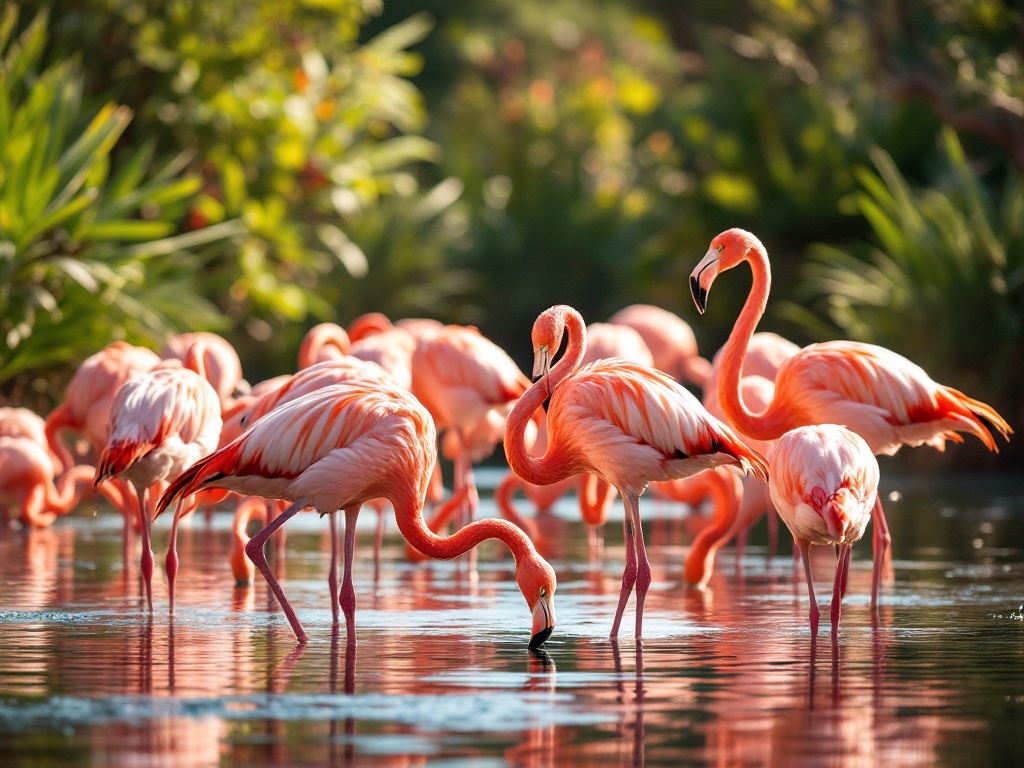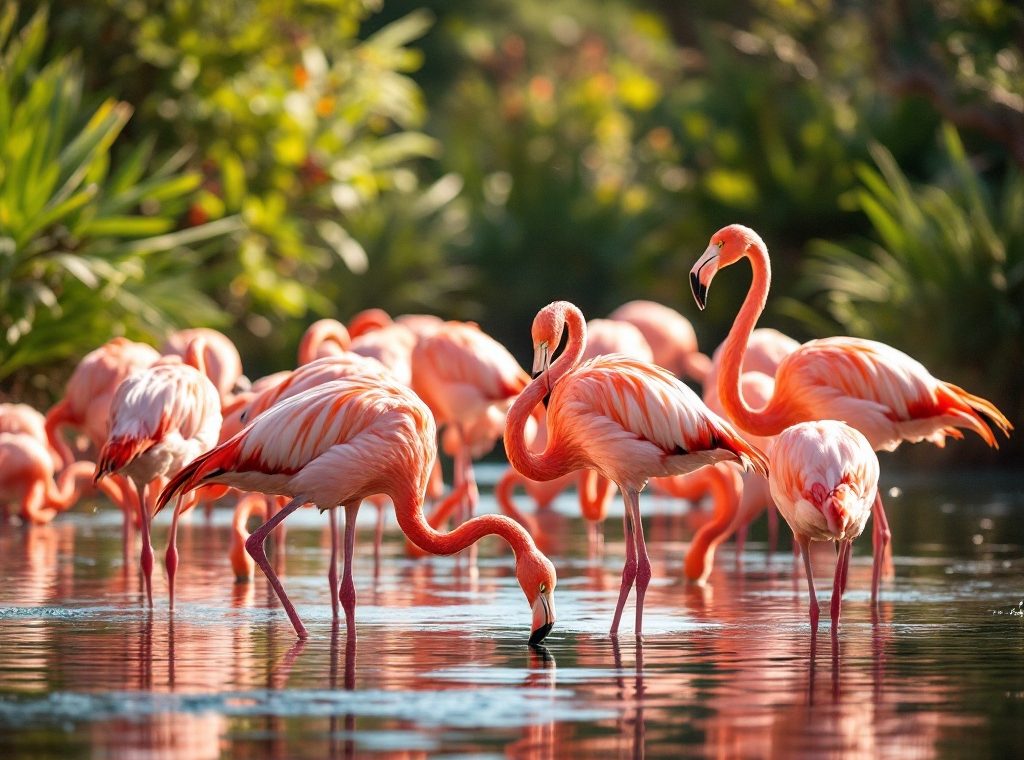The Most Interesting Facts About Flamingos
Discover the vibrant world of flamingos, the wading birds famous for their striking pink plumage and unique behaviors. From their unusual filter-feeding habits and cone-shaped mud nests to their complex social structures and adaptations to extreme environments, flamingos are a marvel of nature. Learn how their diet influences their color, why they stand on one leg, and the threats they face due to habitat loss and climate change. Explore the fascinating lives of these social creatures and discover why conservation efforts are crucial for their survival. Delve into the details of these remarkable birds and uncover the secrets of their flamboyant existence.
Important information

- Flamingos get their pink color from carotenoids in their diet of algae and brine shrimp.
- They are filter feeders, using their beaks to strain food from the water, often feeding upside down.
- Flamingos live in large flocks called flamboyances for protection and efficient foraging.
- They can live in extreme salty environments thanks to special salt glands that filter out excess salt.
- Flamingos often stand on one leg to conserve body heat.
The Fascinating World of Flamingos
Flamingos, known for their vibrant pink plumage and long legs, are large wading birds that congregate in massive flocks called flamboyances. These social creatures thrive in diverse habitats around the globe, including lagoons, estuaries, and salt flats.
What Are Flamingos?
Flamingos, known for their vibrant pink plumage, are wading birds with remarkably long legs and unique feeding habits. As filter feeders, they strain their food directly from the water using their specially adapted beaks. Their diet includes algae, brine shrimp, and small crustaceans.
Six Species of Flamingos
Six flamingo species inhabit Earth: greater, lesser, Chilean, Andean, James’s, and Caribbean. Known for their brilliant pink feathers, these wading birds also possess remarkably long legs and uniquely curved necks. As filter feeders, flamingos congregate in massive flocks, sometimes numbering in the thousands, called flamboyances.
Why Are Flamingos Pink?
Flamingos owe their vibrant pink color to their diet, which primarily consists of algae and brine shrimp. These foods are rich in carotenoids, pigments also found in carrots. The flamingos absorb these carotenoids, which are then deposited in their feathers, skin, and beaks, resulting in the bird’s characteristic pink hue. The intensity of the pink color directly correlates with the amount of carotenoids consumed. A flamingo with a diet rich in carotenoids will display a deeper, more vibrant pink.
Flamingos’ Diet and Carotenoids
Flamingos are famous for their brilliant pink plumage. This striking color comes from beta-carotene, a pigment found in the algae and brine shrimp that make up their diet. The more carotenoid-rich food a flamingo consumes, the brighter its feathers. This vibrant coloration isn’t merely aesthetic; it’s crucial for attracting mates and signaling health and vigor.
How Flamingos Absorb Pigments
Flamingos owe their vibrant pink plumage to their diet, which includes algae, brine shrimp, and crustaceans. These foods are rich in carotenoids, pigments that are deposited in the flamingos’ feathers after being ingested and processed.
Unique Feeding and Nesting Habits
Flamingos, the incredible filter feeders, strain food directly from the water with their uniquely shaped beaks. Often feeding upside down, they use their tongues as pumps, trapping tiny organisms like brine shrimp, algae, and diatoms. Their nests are equally fascinating: cone-shaped mud mounds resembling miniature volcanoes. These sturdy structures offer a safe and stable platform for their single egg, protecting it from predators and harsh weather.
Flamingos as Filter Feeders
Flamingos are remarkable filter feeders, sieving food from the water with their uniquely shaped beaks. Often feeding in shallows with their heads submerged upside down, they consume algae, brine shrimp, and other tiny crustaceans. This specialized beak design efficiently separates their food from mud and sediment.
How Flamingos Eat Upside Down
Flamingos have a unique feeding method, eating with their heads upside down. This posture allows their specialized beaks to filter tiny organisms like brine shrimp and algae from the water. This efficient filtering system helps them thrive in various wetland environments.
How Flamingos Build Mud Nests
Flamingos build unique, cone-shaped nests from mounds of mud. These nests look like small volcanoes or wells. The mounds are usually 12 to 18 inches high. They create a safe place for the single egg the flamingo lays. This protects it from flooding and extreme ground temperatures. The mud hardens as it dries, making the nest strong and long-lasting.
Flamingo Social Behavior
Flamingos are highly social creatures that thrive in large colonies, often numbering in the thousands. These vibrant gatherings, known as flamboyances, offer crucial protection against predators. Foraging also becomes more efficient in a group setting. Flamingos typically mate for life and engage in complex courtship rituals during breeding season. These displays include synchronized head flagging, wing salutes, and unison marching. Such rituals strengthen existing bonds and attract new mates. Constant communication, through honking, grunting, and expressive head and neck movements, reinforces these strong social ties and maintains order within the colony.
Why Flamingos Live in Large Groups
Flamingos thrive in large groups called flamboyances, which offer several advantages. This social structure provides crucial protection against predators such as eagles, hyenas, and foxes. With many eyes watching, the flock can spot danger more quickly. Cooperative feeding is another benefit. Together, they stir up shallow waters to find food like algae and brine shrimp. Lastly, a flamboyance can locate and use scattered food sources more effectively than individual flamingos.
The Significance of a Flamboyance
A flamboyance is the evocative name for a large gathering of flamingos. This term aptly describes their vibrant social lives, as these birds thrive in communities. Their survival depends on these large flocks, sometimes numbering in the hundreds or even thousands, creating a truly spectacular sight.
Monogamous Nature and Courtship Rituals
Flamingos often form lifelong partnerships, lasting for many years. Their strong bond is reinforced through intricate courtship rituals, often involving synchronized movements like head flagging, wing salutes, and marching. These elaborate displays are truly a remarkable spectacle.
Adaptations to Extreme Environments
Flamingos thrive in extreme environments like salty lakes, lagoons, and mudflats. Their unique nasal salt glands filter excess salt, which they then excrete through their nostrils. This adaptation allows them to drink hypersaline water that would be deadly to other animals. Flamingos are often seen standing on one leg to conserve body heat by reducing heat loss through the tucked limb. This is a particularly useful tactic in cold or windy conditions. This posture also minimizes muscular effort, cleverly conserving energy.
Living in Salty Habitats
Flamingos flourish in extreme environments, including alkaline and saline lakes, mudflats, and coastal lagoons. These habitats, often rich in salt and minerals, are deadly for most animals. However, flamingos have a unique adaptation: specialized nasal salt glands. These glands filter out excess salt, allowing them to drink the otherwise toxic water. These remarkable birds can be found in diverse locations, such as Bolivia’s Laguna Colorada, Tanzania’s Lake Natron, and even Utah’s Great Salt Lake.
How Flamingos Sleep on One Leg
Flamingos often sleep standing on one leg, a peculiar posture that helps them conserve warmth by minimizing heat loss. With less surface area exposed to the elements, they stay warmer. This one-legged stance also offers a surprising advantage: increased alertness. By balancing on one leg, they’re primed to react quickly to danger and escape predators.
Flamingo Conservation Status
Flamingo populations face serious threats, endangering their survival. Habitat loss, driven by agriculture and urban development, stands as a primary concern. Climate change further exacerbates the issue, altering water levels and salinity, and rendering habitats less suitable. Consequently, species like the Andean flamingo are now classified as vulnerable on the IUCN Red List, signifying a high risk of extinction in the wild. This vulnerability primarily stems from habitat degradation and human disturbance. These magnificent birds are in dire need of conservation efforts.
Threats: Habitat Loss and Climate Change
Flamingos face serious threats from human activities and a changing climate. These magnificent birds rely on wetlands, which are increasingly being drained for agriculture and development, shrinking their habitats. Rising sea levels, driven by climate change, flood nesting sites and reduce crucial foraging areas. Changes in water salinity and temperature, along with pollution from industrial and agricultural runoff, further impact the food sources these birds depend on. Wetland restoration and protection are critical to ensure their survival.
The IUCN Red List and Vulnerable Species
The Andean flamingo is in real danger of extinction, currently listed as vulnerable. Habitat loss due to mining is a significant threat, disrupting their fragile ecosystem. Climate change further complicates their survival, and human activities add another layer of pressure. Despite these challenges, hope remains. Conservation efforts are crucial to safeguarding these stunning birds, and immediate action is needed to secure their future. The following are the main threats to the Andean flamingo:
- habitat loss due to mining,
- climate change,
- human activities.
Immediate conservation efforts are crucial to protect these magnificent birds and ensure their survival.
Unique Features of the Andean Flamingo
Andean flamingos, distinguished by their pale pink plumage and yellow-tipped beaks, typically inhabit extremely salty lakes for 20 to 30 years. Their diet, surprisingly, consists primarily of algae and diatoms. To survive in these harsh, saline environments, they have developed specialized salt glands that filter out excess salt.
Physical Characteristics and Lifespan
Andean flamingos are easily recognizable by their light pink feathers and the distinctive black triangle marking their backs. In their natural habitat, these birds typically live for 20 to 30 years.
Salt Filtration Adaptations
Andean flamingos have unique nasal glands that filter excess salt from the extremely saline lakes they inhabit. This allows them to thrive in harsh environments where other animals would struggle. This remarkable adaptation enables these vibrant birds to flourish.

















